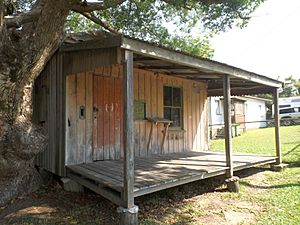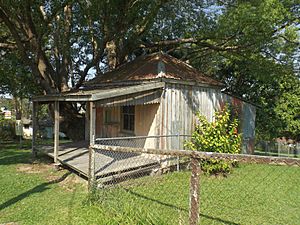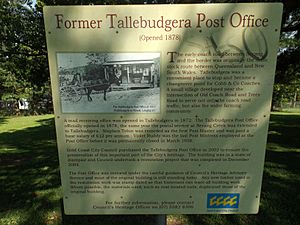Tallebudgera Post Office facts for kids
Quick facts for kids Tallebudgera Post Office |
|
|---|---|

Building in 2015
|
|
| Location | 17 Trees Road, Tallebudgera, Queensland, Australia |
| Official name: Tallebudgera Post Office (former) | |
| Type | state heritage (built) |
| Designated | 1 October 2007 |
| Reference no. | 602624 |
| Significant period | 1870s |
| Lua error in Module:Location_map at line 420: attempt to index field 'wikibase' (a nil value). | |
The Tallebudgera Post Office is a special old building in Tallebudgera, Queensland, Australia. It used to be a post office, a place where people sent letters and parcels. This historic building is now listed on the Queensland Heritage Register, which means it's protected because of its important history. It was added to this list on October 1, 2007.
Contents
Discovering the Post Office's Past
The Tallebudgera Post Office opened its doors in 1878. It served the community until March 1958. This building was unique because it was privately owned and built, not by the government.
Tallebudgera was an important stop along the main stock route. This was a path used to move farm animals between Queensland and New South Wales. It was also a stop for Cobb and Co. coaches. These were like old-fashioned buses that carried people and mail.
In 2002, the Gold Coast City Council bought the old post office. It was in bad shape, so they carefully fixed it up. Today, the Council keeps the building as a museum. It helps people learn about the area's history.
Early Settlement and Growth
European settlers began arriving in the Gold Coast area in the 1840s. They came to cut down cedar trees, which were then sent to Sydney or Brisbane. Timber cutters moved through the thick forests of Tallebudgera. This opened the way for early farmers who started getting land in the 1850s.
By the early 1870s, Tallebudgera had permanent settlers. Most people were timber cutters or small crop farmers. Dairy farming became very important in the area from the 1890s.
Because Tallebudgera was on the main stock route, it became a handy stop. This route later became the main coach road between Nerang and the border. A small village grew near the Old Coach Road and Trees Road. In the 1870s, businesses started appearing. These included a place for travellers to stay, the Rose and Crown Hotel, a general store, and a blacksmith. There was also a wheelwright (who fixed wheels), stables, and a school. More buildings and businesses were added in the 1880s. These included a police station and two churches.
Why Post Offices Mattered
Having a post office was a big deal for small towns. It connected people through mail and was a place for the community to share news. Post offices helped people stay in touch with family and friends. They also linked isolated areas to the government.
In the 1800s, the post office was often the first government building in a new town. It usually had a telegraph office too. This meant they were often in important spots in town. Sometimes, existing businesses would offer postal services. Later, if the town grew, the government might build a special post office. It was quite unusual for a post office building to be privately owned in Queensland.
The land where the post office stands was bought by Stephen Tobin in 1870. A mail service started in 1872. Then, in 1878, the Tallebudgera Post Office officially opened. Stephen Tobin was the first Post Master.
A Privately Owned Post Office
Even though the post office offered a government service, the building itself was never owned by the government. It was very small, with only one room. Most government-built post offices, even small ones, were larger. They often had office space and living areas combined. The fact that the government never replaced this building suggests they didn't think Tallebudgera was big enough for a government-owned facility.
When Australia became a federation in 1901, postal services became the responsibility of the new Commonwealth government. The Tallebudgera Post Office's services moved to the Commonwealth. However, the building stayed privately owned.
The post office offered many services. These included telephone calls, sending parcels, money orders, and savings bank services. People could also get their old age and war pensions there. They could even send telegrams by phone. After World War II, the services slowly decreased. By the time it closed in 1958, it only offered basic postal services.
Much of the Gold Coast's early history has been lost. Many old buildings were pulled down or moved as the area grew. The former Tallebudgera Post Office is one of the oldest buildings still standing. It clearly shows the area's history and how it developed.
What the Old Post Office Looks Like
The former Tallebudgera Post Office is located at 17 Trees Road, Tallebudgera.
The main part of the building is a small, single room. It has a verandah (a covered porch) at the front. It's made of timber using a style called "board and batten." This means flat boards are placed side-by-side, and then thin strips of wood (battens) cover the gaps.
The building is raised off the ground on timber stumps. The front is about 0.5 meters (about 1.5 feet) high. The back is higher, about 1.5 meters (about 5 feet) off the ground. The roof is made of corrugated iron. Inside, there are wooden shelves on the back and right walls. The inside of the roof was once covered with wood panels, and a small part of this still remains.
A "lean-to" extension was added to the back of the building later. We don't know exactly when. This extension is made from corrugated iron sheets. It sits directly on the ground, with the bare earth as its floor.
The original building (without the extension) is about 5.10 meters (about 16.7 feet) wide. It is about 6.0 meters (about 19.7 feet) long, including the verandah which is 2.30 meters (about 7.5 feet) deep. The extension adds another 4.0 meters (about 13 feet) to the building's length.
Most of the building's materials are original. Any new wood used during its restoration has a date stamp. Where possible, new materials like rose-headed nails match the original ones.
A large camphor laurel tree is next to the building on the left side. Its branches spread over the roof. An old photo from 1917 also shows this same tree.
Why This Place is Special
The former Tallebudgera Post Office was added to the Queensland Heritage Register on October 1, 2007. It met several important requirements.
Showing Queensland's History
This post office started in 1878. It is one of the oldest buildings still standing on the Gold Coast. It helps us understand how postal services grew in Queensland. It also shows the early history of Tallebudgera and other small country towns in the area.
A Rare Find
The former Tallebudgera Post Office is special because it was privately owned and built as a post office. Very few other post offices like this still exist in Queensland. Its history, ownership, and unusual design make it important. With just one room and a verandah, it's a unique building from the late 1800s. It is also one of the oldest timber post office buildings in Queensland from that time.
Showing Building Styles
This old post office is a great example of how buildings were made in the late 1800s. It shows early building methods and finishes. It's interesting because it's raised high off the ground. At that time, most buildings were built closer to the ground. It's made of timber using the "board and batten" system. This was before the lighter timber style known as the Queenslander. Even though it's been restored, most of the original building is still there. It's one of the few timber buildings from the late 1800s left in the Gold Coast area.
Its Beautiful Look
The former Tallebudgera Post Office has important aesthetic (beautiful) value. It's a complete building that reminds us of village life in the Gold Coast countryside in the late 1800s. The way the building sits with the old camphor laurel tree next to it makes the whole place feel even more like a rural, historic site.
Important to the Community
The former Tallebudgera Post Office is very important to the people of Tallebudgera. It played a key role in providing essential mail and telephone services to the community for many years.




